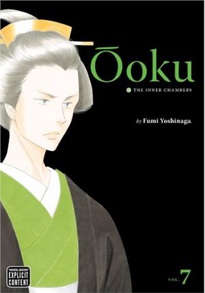Review
by Rebecca Silverman,Ōoku: The Inner Chambers
GN 7
| Synopsis: |  |
||
In the final days of the child shogun's reign, the courtiers wage polite wars over who will be the sickly girl's successor. Different factions both inside and outside of the inner chambers debate and machinate, and ultimately Yoshimune ascends the throne, bringing us back to the beginning of the series. But will her reign bring peace, or will issues continue to arise? |
|||
| Review: | |||
With this volume of Fumi Yoshinaga's alternate history of Japan's Tokugawa period, we finally return to the beginning. The final chapter of this book brings us back where we began in volume one, with the newest female shogun, Yoshimune, reading the secret histories kept by an ancient courtier and learning the reason why women rule instead of men. This informs Yoshimune's policies, and she seeks to make men more than mere sperm-donors and ornaments in their society. The subtext here about how in an unequal society a woman strives to make a move towards equality while history shows that that rarely happens with men in power is quite interesting, and one has to wonder if Yoshinaga wasn't waiting for the chance to put it out there. (Any truth to it depends on one's own philosophy...) While this issue gets but brief treatment in the sole chapter where Yoshimune is the protagonist, it is one that stands out, if only because more action scenes fill it out. This volume actually has the most physical action we have seen in the series thus far. Some of that is the men being put to work as firemen and suchlike, but there are also scenes of torture and more sex than has been explicitly shown. The torture scenes are what really gives the volume its mature rating, with one depicting a woman being forced to kneel on sharpened logs and then having slabs dropped on her lap. While Yoshinaga skimps on the blood, the pain is evident and the horror will linger long after the scene is over. Sex scenes are markedly longer and more detailed than in past books, although nowhere near the level of her yaoi series. Interestingly enough, Yoshimune does not feature in any of them. Most of the book focuses on the years leading up to Yoshimune's ascension to the throne. Her predecessor is a sickly child, something recognized by all of the inner and outer chambers, and there is a strong anti-Yoshimune faction. As always, the fight goes into the inner chambers, with two high ranking courtiers trying to manipulate the situation. This soon becomes tied in with the practice of attending the theatre after a trip to the temple to pray, something that many of the men of the inner chambers do. This allows them to interact with women, and much is made of the fact that the actresses are paid for sexual favors in a direct reversal of the world's norm. Courtier Ejima gets caught up in these political issues to the point where he is used to further one faction's goals over the other, something known in history as the “Ejima-Ikushima Affair.” Yoshinaga sticks fairly close to the historical record, switching only the genders of the major players, and it is moments like these that really make the series. This is history that we can read about, events that we can research, and all Yoshinaga has done, apart from the usual habits of historical fiction writers, is make us look at it in a slightly different way. While this can be said of most of the series, and in fact of the entire premise, localized episodes like this one really bring it into the fore. Viz's Elizabethan translation continues to work, but for those of you who have consistently disliked it, well, you probably won't like it any more seven volumes in. Akemi Wegmuller does an admirable job working with the constraints of an outdated language, specifically in terms of the formal versus the informal “you.” There is one glaring mistake when a character says “hey,” but other than that, language fans should enjoy reading this from a purely linguistic standpoint. Ōoku is a story that is more interested in getting the facts straight than in telling a rip-roaring tale. It slowly meanders along, rich with details and delicately drawn, and while it may not be immediately apparent where Yoshinaga is going with it, it is an immersive and fascinating read. If you like Japanese history and are a fan of Fumi Yoshinaga's understated manga, this one is still going strong and is worth reading. |
| Grade: | |||
|
Overall : A-
Story : B+
Art : A-
+ Finally returns to the series' beginning, more scenes with real meat to them. Beautiful art. |
|||
| discuss this in the forum (2 posts) | | |||
| Production Info: | ||
|
Full encyclopedia details about Release information about |
||